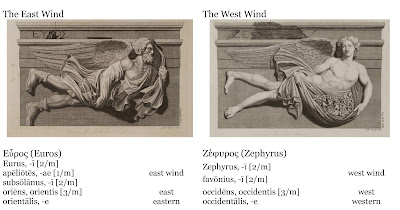Incubuēre marī tōtumque ā sēdibus īmīs / ūna [1] Eurusque [2] Notusque ruunt crēberque procellīs / [3] Āfricus et vastōs volvunt ad lītora flūctūs. (Virgil)
[The winds] fall
upon the sea and they overturn everything from the bottom-most depths –
together, both [1] East Wind and [2] South Wind and,
frequent with gusts, the [3] Southwest Wind – and they roll
huge waves toward the shores.
[i] Images #1 and
#2: Latin has a number of terms pertaining to wind direction which were first discussed
here:
https://adckl.blogspot.com/2024/05/240424-nouns-and-adjectives-referring.html
Ancient Greek
mythology referred to the ‘Anemoi’ / Ἄνεμοι (‘winds’) of which there were four,
each personified as a god. In Roman mythology ‘anemoi’ is ventī (‘winds’)
and the winds were also considered to be gods. The images of the four Gods are
from the Tower of the Winds at Athens.
[1] Boreās, -ae
[1/m]: the north wind
aquilō, aquilōnis
[3/m]; septentriō, septentriōnis [3/m]: north, north wind
aquilōnāris, -e; boreālis,
-e; septentriōnālis, -e: northern
[2] Notus, Notos,
-ī [2/m]: the south wind
auster, austrī
[2/m]; merīdiēs, merīdiēī [5/m]: south, south wind
austrālis, -e; merīdiōnālis,
-e; merīdiānus, -a, -um: southern
[3] Eurus, -ī
[2/m]; apēliōtēs, -ae [1/m]; subsōlānus, -ī [2/m]: east wind
oriēns, orientis
[3/m]: east
orientālis, -e:
eastern
[4] Zephyrus, -ī
[2/m]; favōnius, -ī [2/m]: west wind
occidēns,
occidentis [3/m]: west
occidentālis, -e:
western
compass points
https://adckl.blogspot.com/2024/05/240424-east-and-west.html
Image #3: In
antiquity, the earth was divided into parallel clime zones according to
latitude; Renaissance geographers typically showed nine such
climatic zones, this image also showing the compass points:
septentriō,
septenriōnis [3/m]: north
merīdiēs, merīdiēī
[5/m]: south
oriēns, orientis
[3/m]: east
occidēns,
occidentis [3/m]: west
Image #4: 1472:
publication of Etymologiae of archbishop Isidore of Seville, a 7th
century encylcopedia
The map has East (Oriens)
at the top, South (Meridies) at the right, West (Occidens) at the
bottom, and North (Septentrio) at the left, the central sea labelled as
‘The Great Sea, or Mediterrnean” (Mare magnum sive mediterraneum). The
continents aree named together with the son of Noah accredited with its
settlement: Europa (Japhet / Iaphet), Africa (Ham), Asia (Shem). Jerusalem (Hierusalem)
is placed in Western Asia near the centre of the world, the Garden of Eden (Paradisus)
in the Far East.
Image #5
Sōl in oriente oritur.
│ The sun rises in the East.
Sōl in occidente occidit.
│ The sun sets in the West.
Ventus ab oriente spīrat.
│ The wind is blowing from the East.
Ventus ab occidente flat.
│ The wind is blowing from the West.





No comments:
Post a Comment